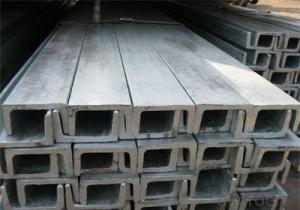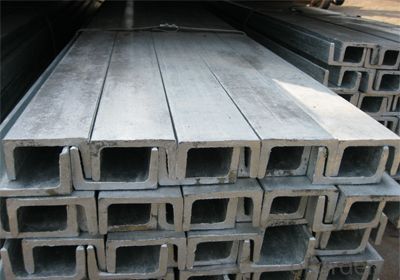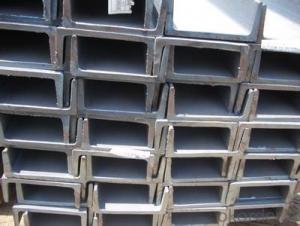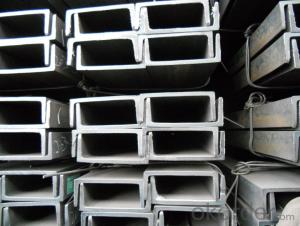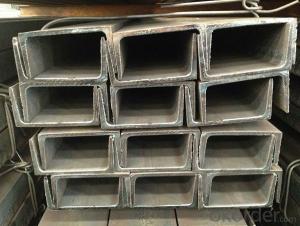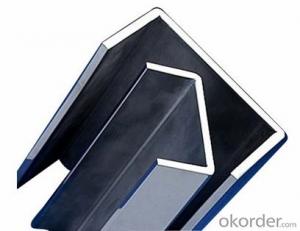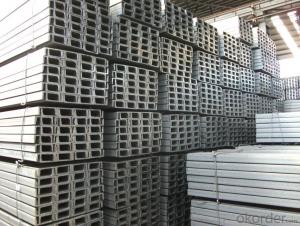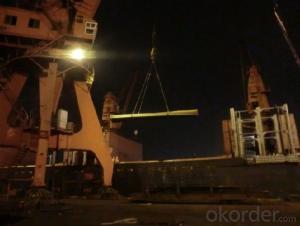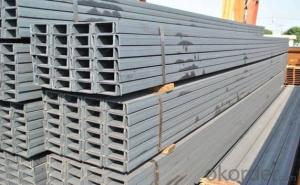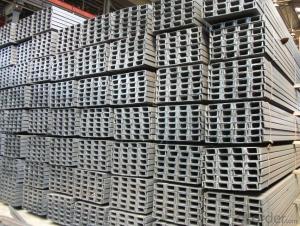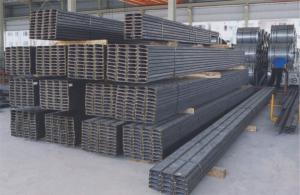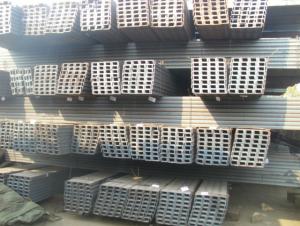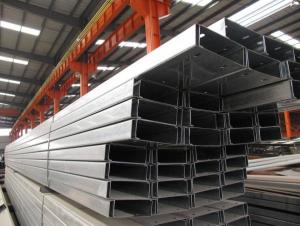Good Quality Steel U Channel For Special Normal Container Used
- Loading Port:
- Tianjin
- Payment Terms:
- TT OR LC
- Min Order Qty:
- 25 m.t.
- Supply Capability:
- 5000 m.t./month
OKorder Service Pledge
OKorder Financial Service
You Might Also Like
Description
In the production of steel products, steel is molded and reshaped with different machinery at different temperatures. One process is steel rolling, which involves metal stock passing through a pair of rolls. Rolling produces flat steel sheets of a specific thickness, and the process is classified according to the temperature at which the metal is rolled. If the temperature of the metal is above its recrystallization temperature, or the temperature at which the grain structure of the metal can be altered, then the process is termed as hot rolling. If the temperature of the metal is below its recrystallization temperature, the process is termed as cold rolling.
Like cold rolling, cold drawing is performed at room temperature, but instead of producing a flat object like a coke can, cold drawing makes steel into the form of a wire like the spokes of a wheel or a paper clip. To start the process, Steel is usual hammered and rolled so that it can be fit through a die; a tool that turns the steel mass into a wire. The room temperature steel is pulled through the die which reshapes it into a thinner shape while maintaining the same volume. It is similar to the idea of syrup flowing out of a bottle through a tube in that it changes shape but not volume, but instead of squeezing the metal, it is pulled out. In order to get the wire down to the right diameter, it usually requires more than one pass through different dies.
Chemical Compostion
Grade | Element(%) | |||
C | Mn | P | S | |
SS330 | -- | -- | ≦0.050 | ≦0.050 |
SS400 | ||||
SS490 | ||||
SS540 | ≦0.30 | ≦1.60 | ≦0.040 | ≦0.040 |
Usage/Applications
Channel Steel is usually used for building structure, vehicle manufacturing and other industrial structure and often used with i beam.
In details, the channel steel belongs to carbon structural steel which is applied to in the field of construction and machinery. The channel steel is usually used for arch-itechtural structure, and they could be welded in order to support or hang a vari-ety of facilities. They are also usually used in combination with I beam. Generally,the channel steel must possess perfect welding property, riveting property and mechanical property and so on.
FAQ:
Q1: How soon can we receive the product after purchase?
A1: Within three days of placing an order, we will begin production. The specific shipping date is dependent upon international and government factors, but is typically 7 to 10 workdays.
Q2: What makes stainless steel stainless?
A2: Stainless steel must contain at least 10.5 % chromium. It is this element that reacts with the oxygen in the air to form a complex chrome-oxide surface layer that is invisible but strong enough to prevent further oxygen from "staining" (rusting) the surface. Higher levels of chromium and the addition of other alloying elements such as nickel and molybdenum enhance this surface layer and improve the corrosion resistance of the stainless material.
Q3: Can stainless steel rust?
A3: Stainless does not "rust" as you think of regular steel rusting with a red oxide on the surface that flakes off. If you see red rust it is probably due to some iron particles that have contaminated the surface of the stainless steel and it is these iron particles that are rusting. Look at the source of the rusting and see if you can remove it from the surface.
Q4: Can stainless steel rust?
A4: Stainless does not "rust" as you think of regular steel rusting with a red oxide on the surface that flakes off. If you see red rust it is probably due to some iron particles that have contaminated the surface of the stainless steel and it is these iron particles that are rusting. Look at the source of the rusting and see if you can remove it from the surface.
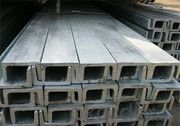
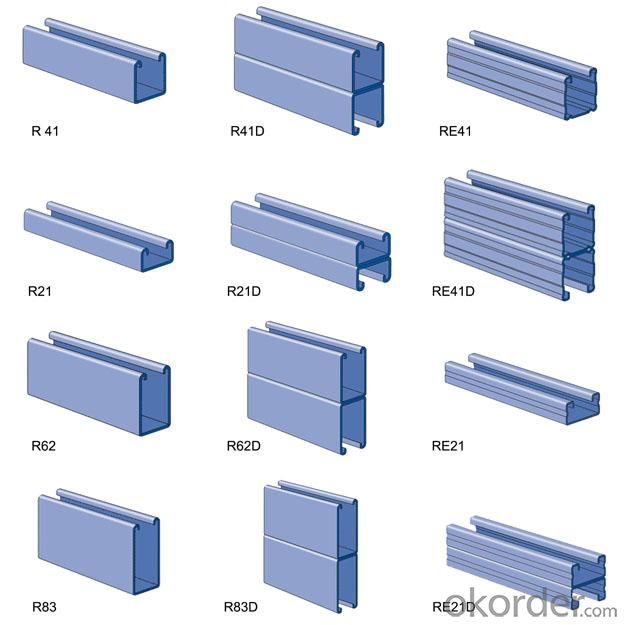
- Q: What are the weight calculations for steel channels?
- The weight calculations for steel channels can be determined using the formula: Weight = (Cross-sectional Area) x (Density of Steel) The cross-sectional area of a steel channel can be calculated by multiplying the width (W) and height (H) of the channel by the thickness (T) of the web. If the steel channel has tapered flanges, the average width (Wa) of the flanges should be used. Cross-sectional Area = (W + 2 * Wa) x H + (T * W) The density of steel is typically around 7,850 kilograms per cubic meter (kg/m³). Therefore, the weight of the steel channel can be calculated by multiplying the cross-sectional area by the density of steel. Weight = (Cross-sectional Area) x (Density of Steel) It is essential to use consistent units for all measurements, such as meters or millimeters, to ensure accurate weight calculations. Remember to check the specific dimensions and specifications of the steel channel being used as they can vary.
- Q: 10# how much is it per kilogram of channel steel?
- Cold rolling edge channel (CJ/YB99-81 standard standard)The height of =120, legs wide =60, short width =20, thickness =3, leg end arc radius =3.0, cross-sectional area (cm2) =7.808, (kg/m) =6.090 theoretical weight (legs bent inward kind)If the non target is not necessarily.
- Q: How do steel channels contribute to the overall sustainability of a structure?
- There are several ways in which steel channels contribute to the overall sustainability of a structure. Firstly, steel is an incredibly durable and long-lasting material. It has resistance to corrosion, weathering, and degradation, meaning that structures built with steel channels have a longer lifespan compared to those made with other materials. This durability reduces the need for frequent repairs or replacements, ultimately decreasing the environmental impact associated with construction and demolition waste. Moreover, steel channels are both lightweight and strong, allowing for the efficient use of materials. This means that less steel is needed to achieve the same structural strength, resulting in reduced resource consumption and energy usage during the manufacturing process. Additionally, steel is a recyclable material, meaning that steel channels can be easily repurposed or recycled at the end of their life cycle. By recycling steel, the demand for new raw materials is reduced, and the energy required in the production of new steel is saved. Furthermore, steel channels offer great design flexibility and versatility, enabling architects and engineers to create innovative and sustainable structures. They can be easily shaped, welded, and assembled, making the construction process easier and allowing for a wide range of architectural designs. This flexibility also allows for future modifications or expansions without the need for extensive demolition or reconstruction. Lastly, steel channels possess excellent fire resistance properties. Steel is non-combustible and does not contribute to the spread or intensity of fires, enhancing the safety of the structure and reducing the risk to occupants and neighboring buildings. In conclusion, steel channels contribute to the overall sustainability of a structure through their durability, efficient use of materials, recyclability, design flexibility, and fire resistance. By choosing steel channels, we can create structures that are not only environmentally friendly but also safe, long-lasting, and cost-effective in the long term.
- Q: How do steel channels contribute to moisture control in buildings?
- Steel channels contribute to moisture control in buildings in several ways. Firstly, steel channels are often used as part of the building envelope, specifically in the construction of walls and roofs. These channels are designed to provide a barrier against moisture infiltration. When properly installed, they help to prevent rainwater, snow, and other forms of precipitation from seeping into the building, thus protecting the interior from potential water damage and mold growth. Secondly, steel channels can be used in conjunction with waterproofing systems to enhance moisture control. Waterproofing membranes or coatings are applied to the surface of the channels, creating an additional layer of protection against moisture penetration. This is particularly important in areas prone to heavy rainfall or high humidity levels. Furthermore, steel channels can be integrated into the building's drainage system. They are often used to direct rainwater away from the building and into the appropriate drainage channels or downspouts. By efficiently managing rainwater runoff, steel channels help to prevent the accumulation of water around the building, reducing the risk of moisture-related issues such as leaks and foundation damage. Lastly, steel channels can contribute to moisture control by supporting the proper ventilation of the building. Adequate airflow is crucial in regulating moisture levels within a building. Steel channels can be used as part of the ventilation system, allowing for the exchange of air and preventing the buildup of excessive humidity, which can lead to condensation and subsequent moisture issues. In summary, steel channels play a significant role in moisture control in buildings. They provide a protective barrier against moisture infiltration, can be integrated with waterproofing systems, help manage rainwater runoff, and support proper ventilation. By addressing these key aspects, steel channels contribute to maintaining a dry and healthy indoor environment while also prolonging the lifespan of the building.
- Q: How do steel channels differ from steel angles?
- Structural steel shapes include steel channels and steel angles, which vary in shape and usage. Steel channels are beams shaped like the letter "C" with a perpendicular web connecting the flanges. They are primarily utilized for structural support in construction projects, providing additional strength and stability to beams, columns, and other structures. Bridges, buildings, and infrastructure projects commonly employ channels. On the other hand, steel angles are beams shaped like the letter "L" with two legs perpendicular to each other. They serve as structural support and reinforcement and have a wide range of applications such as framing, bracing, and supporting various structures. Construction, manufacturing, and fabrication industries commonly use angles. Channels possess a rounded, curved appearance, while angles have a sharp corner where the legs intersect. This distinction in shape results in different mechanical properties and load-bearing capacities. Furthermore, steel angles offer greater flexibility in connecting and joining structural components due to their right-angle shape. They can be easily welded, bolted, or fastened together to create different structures. In contrast, channels are more often used as independent structural elements and have less versatility in connecting with other components. In conclusion, steel channels and steel angles vary in shape, application, and versatility. Channels primarily provide support and reinforcement, while angles offer flexibility in joining and connecting various components. Both shapes play vital roles in the construction and manufacturing industries, contributing to the strength and stability of structures.
- Q: What are the different insulation options for steel channels?
- Steel channels have several insulation options available depending on specific requirements and environmental conditions. Commonly used insulation options include: 1. Mineral wool insulation: With excellent thermal and acoustic insulation properties, mineral wool is a popular choice. It is made from natural or synthetic minerals and is available in forms like batts, blankets, or loose-fill. Mineral wool insulation is non-combustible, moisture-resistant, and effectively insulates against heat transfer and sound transmission. 2. Foam insulation: Foam insulation is widely used and has various types, such as rigid foam boards and spray foam. Rigid foam boards, made of polystyrene or polyurethane, can be easily cut and fitted into steel channels. Spray foam is applied as a liquid and expands into a solid foam, providing superior insulation and air sealing. 3. Fiberglass insulation: Affordable and easy to install, fiberglass insulation is a common choice. Made from glass fibers, it is available as batts or loose-fill. Fiberglass insulation reduces heat transfer and provides acoustic insulation. Proper installation is crucial to avoid gaps or compression that could reduce its effectiveness. 4. Reflective insulation: Reflective insulation is used for its ability to reflect radiant heat. It consists of a reflective surface, often aluminum foil, installed facing an air gap. This air gap reduces heat transfer through radiation. Reflective insulation is lightweight, easy to install, and suitable for steel channels. 5. Cellular glass insulation: Cellular glass insulation is highly resistant to moisture and provides excellent thermal insulation. Made from glass with a closed-cell structure, it is impermeable to water and resistant to mold growth. Cellular glass insulation is commonly used in high temperature or moisture-resistant applications. Factors such as thermal conductivity, fire resistance, moisture resistance, and acoustic performance should be considered when selecting insulation for steel channels. Seeking advice from a professional or insulation manufacturer can help determine the most suitable option based on specific requirements and budget constraints.
- Q: How do steel channels contribute to the overall cost-effectiveness of a project?
- Steel channels contribute to the overall cost-effectiveness of a project in several ways. Firstly, they are lightweight yet strong, allowing for efficient transportation and installation, reducing labor and transportation costs. Secondly, their durability and resistance to corrosion minimize maintenance and replacement expenses over time. Additionally, steel channels are readily available and can be easily fabricated to specific project requirements, eliminating the need for custom-made components and reducing material costs. Overall, the use of steel channels helps optimize project budgets while ensuring long-term structural integrity.
- Q: What are the different types of steel channel accessories?
- Some of the different types of steel channel accessories include brackets, clamps, connectors, end caps, and framing components. These accessories are used to provide additional support, connection options, and finishing touches to steel channel systems.
- Q: Can steel channels be used for creating decorative elements?
- Absolutely, decorative elements can certainly be created using steel channels. With their versatility, steel channels can be molded, trimmed, and joined together in different shapes and patterns. They are perfect for crafting ornamental railings, gates, fences, sculptures, and other intricate architectural features. In addition to their contemporary and polished appearance, steel channels are highly resilient and have an extended lifespan. To further enhance their visual charm, they can be coated or painted with diverse finishes. Whether utilized indoors or outdoors, steel channels present endless opportunities for designing exquisite and one-of-a-kind decorative elements.
- Q: What does channel 150*8 mean?
- The back grade of channel steel is 150MM, and the thickness of channel steel is 8MM
Send your message to us
Good Quality Steel U Channel For Special Normal Container Used
- Loading Port:
- Tianjin
- Payment Terms:
- TT OR LC
- Min Order Qty:
- 25 m.t.
- Supply Capability:
- 5000 m.t./month
OKorder Service Pledge
OKorder Financial Service
Similar products
Hot products
Hot Searches
Related keywords
